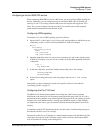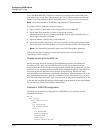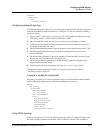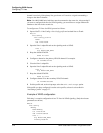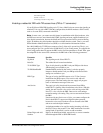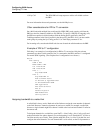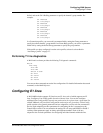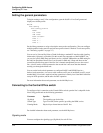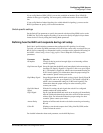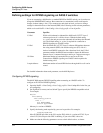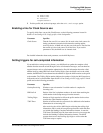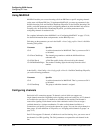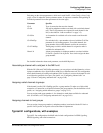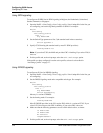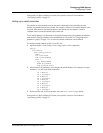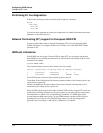
Configuring WAN Access
Configuring E1 lines
MAX 6000/3000 Network Configuration Guide 3-21
If you set Sig Mode to ISDN_NFAS, you can also establish an interface ID or NFAS ID
number for this type of signaling. You must specify a different interface ID for each NFAS
line.
If you set Sig Mode to Inband signaling (also called robbed-bit signaling), you must set the
Rob Ctl parameter to specify a call-control mechanism.
Switch-specific settings
Set the Switch Type parameter to specify the network switch providing ISDN service on the
E1/PRI line. The carrier supplies the setting. You must also specify the physical-layer frame
format for the E1 line by setting the Framing Mode parameter.
Defining how the MAX unit responds during call setup
Each Line N profile includes parameters that configure the R2 signaling for call setup.
Typically, you set the Sig Mode parameter to R2, and all the correct tones are selected for you.
But if you are connecting to a nonstandard switch, you might need to adjust the R2 settings in
the Net/E1 > Line Config > Line Config profile > Line N subprofile. Following are the
parameters:
For detailed information about each parameter, see the MAX Reference.
Parameter Specifies
#Complete Criteria for having received enough digits on an incoming call that
uses R2 signaling.
Grp B Answer Signal Group B signal that the MAX sends immediately before answering an
incoming call. Specify Signal B 1, Signal B 2, and so on, up to Signal
B 15. The default is Signal B 6, which is the recommended setting for
E1 R2 Israeli signaling. For information about the proper settings for
other countries, please contact your carrier.
Grp B Busy Signal Group B signal that the MAX sends as a busy signal. Specify Signal B
1, Signal B 2, and so on, up to Signal B 15. The default is Signal B 3,
which is the recommended setting for E1 R2 Israeli signaling. For
information about the proper settings for other countries, please
contact your carrier.
Grp B No Match
Signal
With the Yes setting, the unit signals the switch if no configured
number matches the called number.
Grp II Signal Grp II signal that the MAX unit sends on an outgoing call immediately
after the called end acknowledges that it has received all the necessary
address digits. For information about the proper settings for other
countries, please contact your carrier.
Answer Delay Number of milliseconds the unit waits before answering an incoming
R2 call.
Caller ID Whether or not the unit requests the Calling Line ID (CLID) and/or
Caller ID from the switch.



